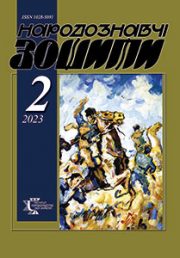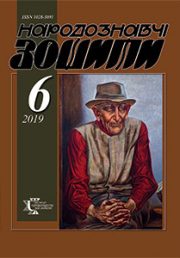The Ethnology Notebooks. 2020. № 3 (153), 622—636
UDK 7.04:75.02:003.77](477):811.145
DOI https://doi.org/10.15407/nz2020.03.622
SKOP Mykhailo
ORCID ID: https://orcid.org/0000-0001-5901-8211
Postgraduate student,
the Lviv National Academy of Arts,
38, Kubiiovycha Street, 79011, Lviv, Ukraine,
Contacts: e-mail: neivanmade@gmail.com
Abstract. The Holy Mandylion is one of the scenes that are included in the Ukrainian iconostases and ecclesiastical polychromies of the XV—XVI centuries. The iconography of the Holy Face influenced not only the composition but also the placement of the icon in the temple. In the Ukrainian tradition, the Holy Mandylion was based above the royal gates in the iconostasis. As a result, the Ukrainian Mandylion have a characteristic elongated shape. This feature led to the appropriate placement of elements of iconography. In particular, the elongated form of the towel. But the preserved monuments testify to the occasions of placing the Holy Face not above the royal, but above the deacon’s door. And also, about the possibility of duplication of the plot in one row. Due to the interconnection of the local interpretation of iconography with the artistic manner of the artists, considerable attention was drawn to the artistic features of the Mandylions. So considered a number of icons from 15th century from Lemkivshchyna, which have common features that allow one to speak about the belonging of the works to one artistic center, and also, in the case of two works, one author. On the example of these icons, the assumption is made about the possible reasons for the rare selection of archangels holding a tablecloth.
Assumptions are made about their origin. A question was raised about reading an inscription on icon from Zarudtsy, which had not been sufficiently researched before. During the comparison of the icon with similar specimens of Greek sacred art of the XV—XVI centuries, the inscription was identified as an imitation of the Greek minuscule. Six words have been assumed. The origin of the inscription has been suggested. A comparison is made with two other icons of the 16th century. Common features have been identified that indicate their stylistic relationship. The semiotics of the icon from Ustianiv-Gorishna, which attributed to the master Alexei Goroshkovich, was analyzed. Original compositional and decorative solutions that not found on other stored icons of this period have been identified. The decoration, attributes and decor of the archangels are discussed in detail. The possible reasons for the absence of rods in their hands were mentioned. The decorative element on the red dress, which was very popular in the Ukrainian icon painting of the 15th—16th centuries, was identified as a Chintamani sacred sign.
Keywords: iconography, semilogy, Oleksy Horoshkovish, Mandylion, Holy Face, Chintamany, Greek minuscule.
Received 4.05.2020
REFERENCES
Helitovich, M. (2003). Icons of the Holy Mandylion of the late XV — beginning XVII c. in the collection of Lviv National Museum from the collection of the Museum of the Lviv Theological Seminary — Theological Academy (materials to the consolidated catalog of the icon-painting of the Lviv National Museum). Ukrainian Greek Catholic Church and Religious Arts (Historical Experience and Problems of Modernity (Issue 2, pp. 63—74). Lviv [in Ukrainian].
Evseeva, L. (2008). The Holy Face in the XV—XVI centuries. The Holy Face in the Russian Icon. Moscow: Moskovskiye uchebniki i Kartolitografiya [in Russian].
Demetrius, Patriarch (Yarema) (2005). Icons of the Holy. Iconography of Western Ukraine of XII—XV centuries. Lviv: Drukarsky Kunshty [in Ukrainian].
Taranushenko, S. (1994). Ukrainian iconostasis. Notes of the Scientific Society of T. Shevchenko (Pp. 141—170). Lviv [in Ukrainian].
Skop-Druziuk, G. (1997). The iconographic features of the Mandylion by Job Kondelevich. Volyn Icon: Issues of History of Study, Research and Restoration: Reports and Materials IV Scientific Conferences (Pp. 26—31). Lutsk [in Ukrainian].
Demetrius, Patriarch (Yarema) (2017). Iconography of Western Ukraine XVI — beginning. XVII century (Pp. 370—377). Lviv: Drukarsky Kunshty [in Ukrainian].
Scholastic, E. (2010). Church history in six books. St. Petersburg: Oleg Abishko Publishing House [in Russian].
Wagner, G. (1974). The problem of genres in ancient Russian art. Moscow: Art [in Russian].
Druziuk, G., & Skop, L. (1990). History of the creation of the altar barrier in the Church of the Assumption of the Virgin in the Novoselica village in Transcarpathia. Cultural monuments. New discoveries. Literacy. Art. Archeology. Yearbook 1989 (Pp. 204—218). Moscow: Science [in Russian].
Skop, L. (2004). The Holy Mandylion of the end of XV century from the village Zubrytsy, Rykova, and Ranevich. Painter of the Icon of the Virgin-Odigitria from the village Mrazchnica. Ukrainian Iconographers (Pp. 73—81). Lviv: Logos [in Ukrainian].
Sventcitskaya, V. (1977). Master of icons of the XV century from Vanivka and Zdvizhen. Ancient Russian art. Problems and attributions (Pp. 291—320). Moscow: Nauka [in Ukrainian].
Onash, K. (2002). Icons: fakts and legends. Warszawa: Arkady [in Polish].
Strong, J. (1984). Greek dictionary of the New Testament (P. 540). Albany: Thomas Nelson Publishers.
Liddell, H., D., D., Scott, R., & D., D. (1961). A Greek-English Lexicon (P. 2111). Hardcover: Clarendon Press.
Newman, B. (2012). The Greek-Russian Dictionary of the New Testament (Pp. 240). Moscow: Russian Bible Society [in Russian].
Meychan, D. (2012). New Testament Greek Workbook (Pp. 242). Moscow: Russian Bible Society [in Russian].
Salko, N. (1971). New about Theophanes the Greek. Obrazotvorche mystetstvo, 2. Kyiv [in Ukrainian].
Kochetkov, I. (1984). Is the icon «Our Lady of the Don» a monument to the Battle of Kulikov? Ancient Russian art. XIV—XV centuries. Moscow: Nauka [in Russian].
Pyatnitsky, Y. (1997). The problem of individualization of handwriting in the artistic style of the XV century (Nikolaos Lambudis from Sparta’s icongraphic school). Hermitage readings in memory of B.B. Piotrovsky (Pp. 69—72). St. Petersburg: Publisher of the State Hermitage Museum [in Russian].
Dragan, M. (1970). Ukrainian decorative carvings of XVI—XVIII centuries. Kyiv: Naukova Dumka [in Ukrainian].
Zholtovsky, P. (1978). Ukrainian painting of the XVII—XVIII centuries. Kyiv: Naukova Dumka [in Ukrainian].
Grьnwedel, A. (1900). Mythologie des Buddhismus in Tibet und der Mongolei. Leipzig: Bkockhaus [in German].






